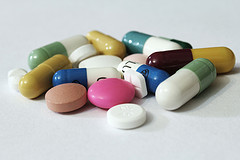Watch Out for Counterfeit Drugs on your Trip
28 February 2012
Drugs sold outside the U.S. may not meet the same standards for quality that are regulated back home. In some situations, drugs sold in other countries will contain different amounts of the active ingredient or they may be named differently. In the worst scenario, the drug could contain toxic ingredients or be counterfeit – completely fake.
Drug counterfeiting is a growing problem around the globe, especially in less developed countries. The Centers for Disease Control (CDC) have found that while many drugs sold outside the U.S. can be counterfeit, one that is often marketed to travelers in countries where malaria is a primary health risk are the drugs to prevent malaria.
Indications that a drug may be fake
While the only 100% reliable way to know if a drug is real or fake is through chemical analysis done by a trusted laboratory, there are some indicators that you can look for to know if a drug is fake. First, the drug may be in poor-quality packaging or have misspelling words on the label.
In addition, some counterfeit tablets will:
- break apart far too easily
- have a strange taste or smell
- be unusually colored
- be unexpectedly cheap
These are not guarantees that the drug is fake – just indications that the drug is more likely to be a fake.
Avoiding the risk of replacement drugs when you travel
Because the quality and safety of drugs purchased outside the U.S. cannot be guaranteed, it’s critical for travelers to have enough of the drugs they need before they leave on a trip. This is one reason you may want to see your doctor before you travel – so that you have enough medication for your trip and you have updated prescriptions for your regular medications.
Make a copy of those prescriptions and save them to an electronic device you will travel with, or send them to yourself as an email attachment.
If you must buy medicine on your trip
In some cases, such as when you have extended your stay and run out or if the drugs are stolen from you, your only option is to purchase replacement medications on your trip. If this is the situation you are facing, having a copy of your prescription can make a big difference.
- Only purchase drugs from licensed pharmacies and be sure to get a receipt (for your travel insurance claim and/or to report counterfeit drug sales if the drug proves to be a fake). Do not buy medicines from open markets.
- Check to see if the drug has the same name and ask the pharmacist whether it has the same active ingredient as the one you were taking. (If you still have the original container, that may help.)
- If you don’t understand the local language, contact your travel insurance provider’s assistance services line and ask whether they can help determine whether the replacement medication is adequate for your needs. Often, they will have drug translation guides or can contact your doctor back home to verify whether the drug will be safe.
Check out these related topics
Damian Tysdal is the founder of CoverTrip, and is a licensed agent for travel insurance (MA 1883287). He believes travel insurance should be easier to understand, and started the first travel insurance blog in 2006.

